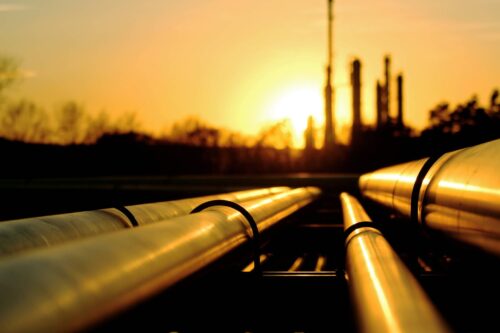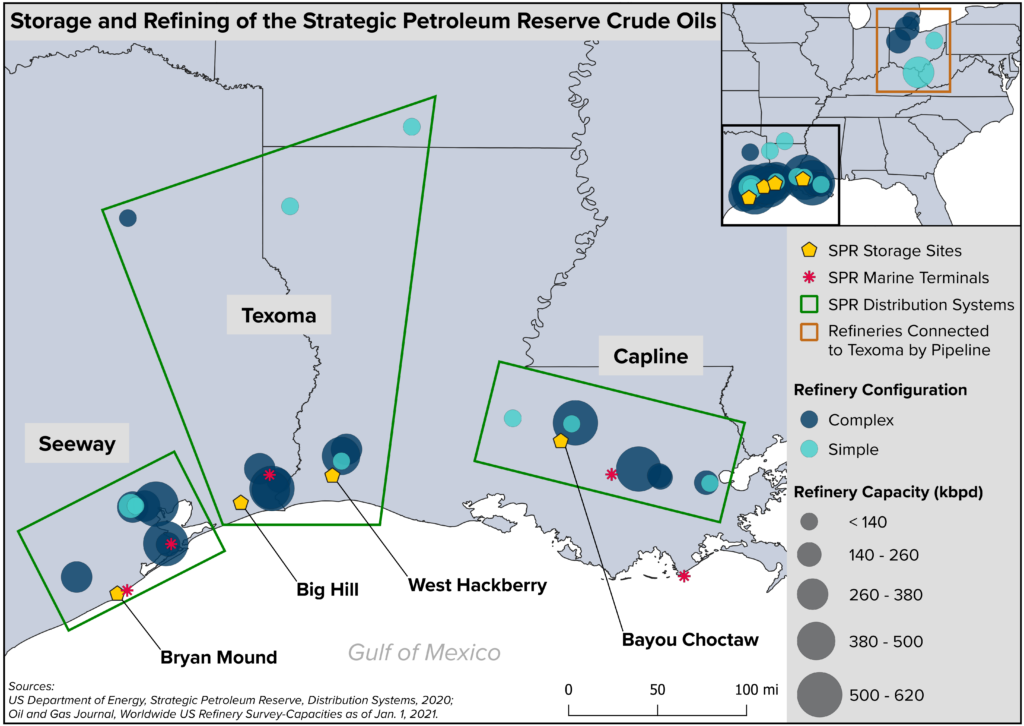
Is the US Stockpiling Dirty Oils?
How Greater Data Transparency Can Reduce the Climate Impacts of the Strategic Petroleum Reserve
In response to Russia’s war in Ukraine, President Biden authorized the largest-ever Strategic Petroleum Reserve (SPR) drawdown in March 2022. The economic benefits may appear clearcut, but the environmental impacts of SPR withdrawal are less certain. It is essential that policymakers lessen US dependence on fossil fuels, and in the meantime, preferentially stock the SPR with the lowest emissions intensity oils. This will reduce climate impacts when emergencies like the war in Ukraine arise.
The US Strategic Petroleum Reserve (SPR) was established by Congress in 1975, calling for one billion barrels of crude oil and petroleum products to be stored underground. The SPR’s goal: “to protect the United States from severe petroleum supply interruptions.” The Administration’s decision to authorize the release of one million barrels of oil every day for the next six months resulted in a sharp drop in oil prices.
SPR climate footprints depend on whose oils are stored in the SPR — and which oils are being released. Individual domestic and international oils have wide-ranging climate footprints that vary by an order of magnitude, depending on how an oil is produced, refined, and shipped. Overall, basic knowledge about oil is too opaque, hindering the clean energy transition. Greater oil (and gas) data transparency is needed to guide SPR decisions and stem the flow of the world’s dirtiest oils.
What the SPR Does and Does Not Do
The SPR has played a role in US energy policy since its inception nearly a half century ago, temporarily safeguarding Americans from spikes at the gas pump. As the world’s largest supply of emergency oil, its 714 million barrels of federally purchased oils contain a mix of domestic and foreign crudes.
Beyond this, Americans know little about SPR oils, their origins, and their security or climate consequences. For example, the SPR may currently contain oil from Russia. And without knowledge about the origin of SPR oils, we cannot assess the greenhouse gas (GHG) emissions resulting from SPR releases.
The SPR also does not guarantee American energy independence. The United States currently imports as much oil as it exports. In January 2022, the country imported over 8 million barrels per day (bpd) of oil and petroleum products and exported another 9 million bpd. The United States buys and sells more oil than the 16 million bpd it refines. US crude oil imports also regularly exceed the SPR max drawdown rate.
Most critically, the SPR does nothing to help the United States transition off fossil fuels. By providing emergency oil supplies, Americans are buffered from the reality of oil price volatility that is an important market signal to hasten a clean energy transition. According to the Congressional Research Service, the changing role of the United States in world oil markets (as well as climate pledges) is driving a debate about the SPR.
How Dirty Is SPR Oil?
There is no standard oil. Depending on the resource and how it is produced and refined, two otherwise equivalent barrels can emit markedly different amounts of GHG emissions. The climate footprints of lighter oils can vary by 10 times or more, depending on their associated emissions when methane leaks through the supply chain. Heavier oils require significant work and energy to extract and process, which can also vary significantly depending on the fuels used.
No essential data is provided to ensure that only those oils with the lowest climate intensities are stockpiled in the SPR caverns. While their design is detailed, the SPR’s four buried salt caverns along the Gulf Coast are said to contain lighter oils. But even that is uncertain. The SPR could contain methane-intensive oil from the Permian Basin or dirty oils from Mexico, Canada, or Indonesia that, on average, can be three times more polluting than those with lower emissions intensities from Saudi Arabia, Norway, or the United Arab Emirates (Exhibit 1).
Mismatch Between SPR Crudes and US Refineries
An array of pipelines connects the crude flowing out of the SPR into about 30 US refineries. These processing facilities differ in complexity depending on their crude diet. Not every refinery can efficiently process different qualities of crude. The lightest oils use simple (hydroskimming) refineries that minimally process oil into different petroleum products. The heaviest oils require complex (deep conversion coking and hydrocracking) refineries that use high temperature and pressures to reconfigure these high-carbon resources into gasoline, diesel, and other products.
Refineries differ not only in their operations, but also in their climate intensities. Studies estimate that, on average, deep conversion refineries are three times more climate intensive than hydroskimmers. Therefore, tracking SPR oil flow into US refineries has material climate impacts.
Refineries in Texas and Louisiana are the main recipients of SPR oil releases (Exhibit 2). The majority of these facilities are deep-conversion refineries that consume a steady diet of heavy oils and are not well equipped to refine the SPR’s lighter crudes. An estimated 81 percent of current SPR refining capacity is designed to handle heavy crudes in deep conversion refineries rather than the lighter oils produced today in the United States. Mismatches in oil feeds and refinery configurations impose GHG penalties.
Exhibit 2: Map of SPR Storage Facilities and Interconnected Refineries by Capacity and Configuration
A Call for Greater Data Transparency
Using federal funds to fill the SPR offers an incentive to consider the climate impacts when it comes to sourcing oils. For example, if the one-million-barrel withdrawal over the next six months were selectively purchased from the lowest climate intensive oils, the current SPR release could save an estimated 90 million tons of CO2e. This is equivalent to the emissions from 40 million cars — one in every seven on US roads today — over the same timeframe.
Greater oil data transparency would not only support reducing SPR climate impacts. With this climate intelligence, oils (and gases) could be priced and managed according to their wide-ranging climate intensities. Such efforts are underway. Companies are starting to differentiate themselves from competitors that hold higher-intensity assets, and investors are pressuring operators to chart a zero-carbon path. Industry experts are promoting oil and gas supply chain decarbonization.
Oil market volatility elevates economic, political, energy, and environmental risks. But volatility also motivates a clean energy transition. Armed with data, markets and policymakers can steer the United States and the world to a low-carbon energy future. A good place to start is strategically refilling the SPR. This is an opportunity we cannot afford to miss.

